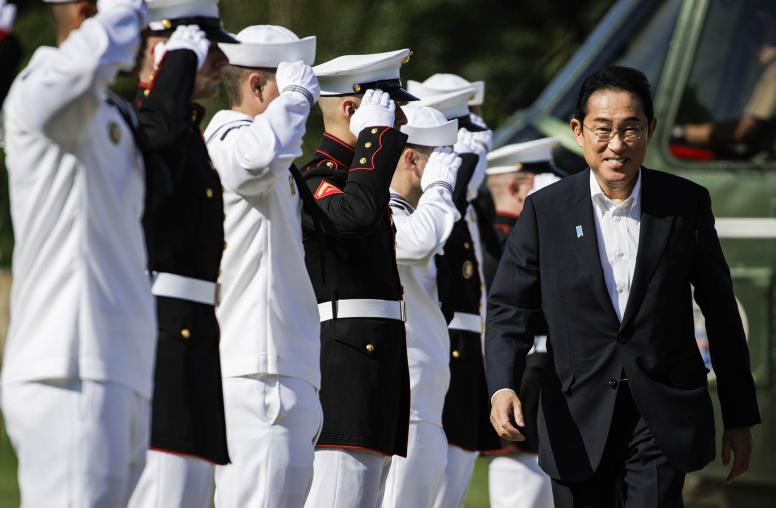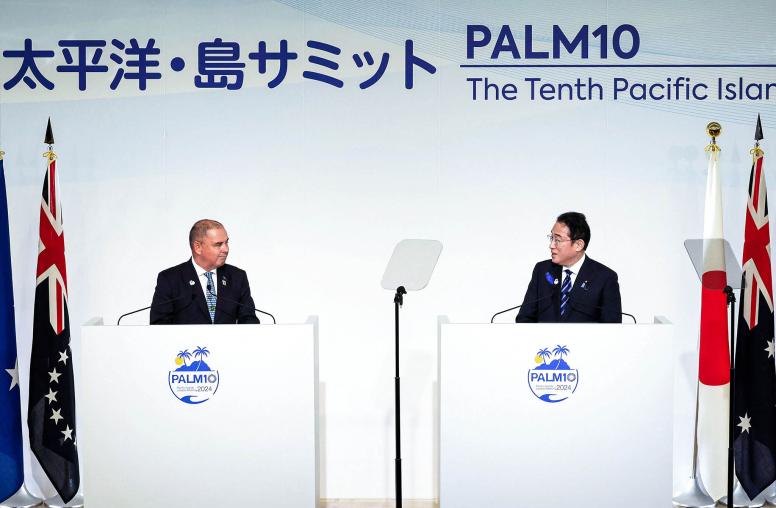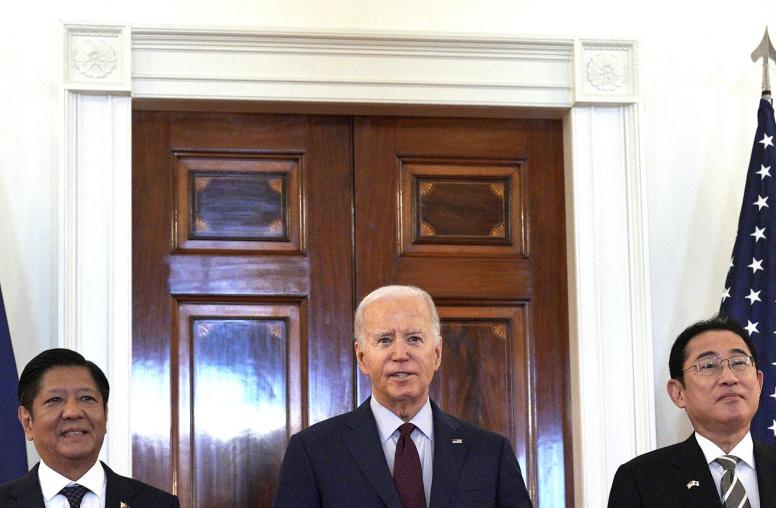A Formula to Resolve the South Korea-Japan Wartime Forced Labor Issue
By helping to settle this historical dispute, the United States can advance its economic, political and security interests in the Indo-Pacific region.
As the United States revitalizes its alliances in East Asia, World War II reparations issues loom large. The United States’ two closest allies in the region — Japan and South Korea — remain at odds on issues ranging from forced labor that Koreans performed for Japanese corporations to the comfort women system of sexual enslavement. The failure to redress these issues has stretched the bilateral relationship to its thinnest point in 50 years. Although the new administration in Seoul promises a more “forward-looking” approach to Japan, resolution of various historical issues seems unlikely in the near term.

The Need for a New Approach
A new approach is needed. The Biden administration should exercise regional leadership, facilitate negotiations between Seoul and Tokyo, and encourage the two sides to seek a lasting peace based on thoroughly airing the issues.
Although South Korea and Japan have devoted considerable energies to remedy the comfort women issue, the forced labor issue remains unresolved, poisoning the current relationship. Both sides should work toward a joint understanding of the colonial era and wartime period, one that acknowledges Japan’s inhumane treatment of many Koreans, as well as Korean complicity in Japanese colonialism. This is not to equate Imperial Japan’s inhumanity with Korea’s complicity. Rather, a recognition of harm on both sides will put to rest the evasiveness of Japan’s current leadership and the victim mentality that many Koreans have adopted about the colonial period.
Three Elements of a Solution
In 2018, the Supreme Court of South Korea ordered two Japanese corporations to compensate Korean forced laborers and their heirs. But, nearly four years later, neither corporation has made payment. Meanwhile, several other cases are pending in South Korea.
Tokyo and Seoul should, with contributions from Japanese corporations, establish a compensation mechanism to redress the forced labor issue. Past experience provides a host of lessons to establish a successful compensation mechanism. For the past three decades, Chinese and Korean forced laborers (among others) have filed more than 100 lawsuits in Japan, China, South Korea and the United States, seeking apologies, compensation and other forms of redress. With varying degrees of court involvement, Japanese corporations have settled disputes by providing financial compensation, performing memorial services and erecting commemorative steles — establishing a repertoire of redress. The present challenge is to combine these reparative elements into a solution that satisfies the few surviving Korean forced laborers and the Japanese companies that used their labor.
A review of previous conciliation agreements suggests three elements will be helpful in resolving the forced labor issue. First, the mechanism should pay financial compensation. Second, victims should be commemorated. Third, Japanese corporations should acknowledge the harm visited upon the forced laborers and offer an apology.
Financial compensation is a necessary element of redress, even as the amount has varied. To be sure, no amount of money can adequately remedy the abuse, isolation, hunger and other trauma that many Korean forced laborers endured while in Japan. But symbolism matters: many forced laborers never received a sen of payment for their labor in Japan, much less acknowledgment or reparation for their physical and mental suffering. In the most comprehensive reconciliation agreement to emerge from East Asia’s war reparations movement, Mitsubishi Materials paid approximately $15,000 each to Chinese forced laborers, in addition to medical benefits, and educational support for their descendants. In prior agreements with Korean forced laborers, Japanese corporations have paid between $16,000 and $34,000 per person — a fraction of the $89,000 to $134,000 compensation that the Supreme Court of South Korea ruled Mitsubishi Heavy Industries Ltd. (MHI) must pay victims of forced labor in 2018. But the amount of money is not as important as the act of compensation itself. How to characterize the compensation — unpaid wages, damages for physical harm or solatium (for emotional distress) — is crucial. Since Japanese corporations emphasize the “humanitarian” nature of these payments to avoid the implication that they committed a compensable wrong, it may be difficult to agree on a phrase that satisfies both Korean forced laborers and Japanese companies.
The Importance of Commemoration
More important than compensation, however, is commemoration, whether it is in physical form (stele, cenotaph, museum), ritual form (memorial service) or both. Commemoration acknowledges the suffering of victims and ensures that future generations recognize the human toll of forced labor. In a 1997 agreement between the heirs of Korean forced laborers and Nippon Steel, the latter erected a “spirit-calming shrine” in its factory to commemorate Korean forced laborers killed during an Allied air raid. The company also conducted a memorial service to honor the slain Koreans and partially covered the costs of Korean plaintiffs to attend a service at its foundry in northeastern Japan. Nippon Steel further supported a memorial service in South Korea and gave each plaintiff $18,000 in consolation money for the loss of life. In other conciliation agreements, Japanese companies have erected steles, cenotaphs and even a museum.
One especially controversial form of commemoration is accurate accounts of the war in Japanese history textbooks. From 1965 to 1997, the late Japanese historian Ienaga Saburō prosecuted three lawsuits to challenge state censorship of the account of Japan’s wartime conduct in his high school history textbooks. In 1982, a major contretemps erupted between Japan and China when the Japanese education ministry proposed that textbooks read Japan “advanced into China” during the 1930s, rather than the more historically accurate “invaded.” More recently, conservative Japanese politicians have removed references to Korean forced labor from high school history textbooks. Suppressing this history, however, has only inflamed regional tensions. It also runs counter to the Kono Statement, a 1993 apology issued by Japan’s chief cabinet secretary that promised to engrave the comfort women issue “in our memories through the study and teaching of history.” South Korean objections to Japan’s views of history have also stymied contemporary efforts to designate the Sado mine, which used more than 1,000 Korean forced laborers during the war, as a UNESCO world heritage site.
The Case for an Apology
The final element is an apology. Chinese and Korean plaintiffs have stated that obtaining an apology is their paramount motivation for suing. To extract an apology, negotiators must outline the illegal acts that Japanese companies committed during the war. Numerous Japanese court decisions have concluded Korean plaintiffs performed “forced labor” under miserable conditions. For example, in a case against MHI, the Nagoya High Court found that Japan violated the 1930 Forced Labor Convention by recruiting underage Korean girls — a relatively rare admission in the context of war reparations lawsuits. The same court specified that MHI subjected Korean plaintiffs to grueling conditions and inadequate nutrition, prevented them from leaving the factory and restricted their communications with the outside world.
Japanese companies have, on occasion, apologized to Chinese forced laborers. Yet they have not publicly apologized to Korean forced laborers. Why? Whereas Japan’s wartime conscription of Chinese labor often took place at gunpoint, Japan recruited Korean labor pursuant to the 1938 National Mobilization Law. In this view, Korean forced labor was “legal” because it stemmed from a law that applied to Koreans as subjects of Imperial Japan. Moreover, Japanese companies used Korean labor to support the war effort (e.g., building tanks, mining coal, creating power plants, etc.), not to realize private gains. Of course, this view obscures much of the damage that Japanese companies inflicted upon Korean forced laborers during their time in Japan. Even if the mobilization took place under then-applicable Japanese law (and many Korean courts have determined that the mobilization process was not legal), the companies’ treatment of Korean labor was frequently brutal — a violation of Japan’s own legal standards of the 1940s. Yet Japanese corporations refuse to recognize the illegality of their conduct, much less apologize. The treatment of Korean forced laborers in Japanese mines, factories and ports, however, deserves nothing less.
A Role for the United States
The United States can encourage the reconciliation process. To be sure, Japan and South Korea must chart the precise contours of a compensation mechanism, ideally with the participation of corporate Japan. But Washington has a history of nudging allies to resolve war reparation issues. The Clinton administration performed a conciliatory role in the late 1990s, prodding European states to develop compensatory mechanisms to resolve various World War II-era human rights abuses. In 2000, Germany established a $5.2 billion fund, Foundation Remembrance, Responsibility and Future, to compensate more than 1 million forced laborers and other victims of the Holocaust. While individual payments were small, the acknowledgment salved one of Europe’s long-festering grievances. Even now, the foundation provides grants for research into forced labor and other human rights abuses — a wonderful example of trading evil for good. Likewise, the French and Swiss governments set up administrative tribunals in Paris and Zurich, respectively, to restore property (financial, artistic, immovable or otherwise) looted by Nazis or Nazi collaborators. The degree of U.S. involvement varied in each instance, though it is unlikely that any European government would have revisited war reparations without U.S. intervention.
The Biden administration should emulate the bold approach of prior U.S. administrations. In 1998, then U.S. President Bill Clinton appointed Stuart Eizenstat, who served as U.S. ambassador to the European Union from 1993 to 1996, to be a special representative on Holocaust issues. Eizenstat spent the next three years negotiating compensation mechanisms with Germany, France, Austria and Switzerland. A respected figure with diplomatic experience in East Asia could serve a similar role in the Biden administration.
Similarly, the Obama administration worked with officials from the administrations of the late Japanese Prime Minister Shinzo Abe and then South Korean President Park Geun-hye to devise the 2015 “comfort women” agreement. A similarly hands-on approach is warranted for the forced labor issue.
Some may view then South Korean President Moon Jae-in’s rejection of the comfort women agreement in 2018 as proof that the United States should remove itself from the war reparations space. But the absence of U.S. leadership under the Trump administration hardly improved the situation, as the fraying of South Korea-Japan relations attests. Moreover, the 2015 comfort women agreement — which was neither signed by the countries’ leaders nor ratified by their legislatures — did not address key demands that Korean comfort women have sought since the early 1990s, such as an apology that recognizes the legal responsibility of Japan’s wartime government, and references to the comfort women system in Japanese history textbooks.
U.S. support for a compensation mechanism could increase the likelihood that Japan takes the proposal more seriously. When Moon proposed a compensation fund for forced labor in 2019, the Japanese government rejected it; many in Japan pointed to his withdrawal from the comfort women agreement as a sign that he could not be trusted. U.S. backing for a compensation mechanism, however, would push Tokyo to revisit the issue, and expand the breadth and scope of redress, ideally to include some forms of reparations noted above.
The Way Forward
Resolving war reparations issues will be difficult, but a compensation mechanism can help overcome the narrow path laid out by South Korean courts. To be sure, Japan and South Korea will strain to achieve even one, much less all three, of the reparative elements. But the status quo is unsustainable, suggesting the need for a new strategy.
With Northeast Asia’s security environment increasingly perilous, the United States must ensure that South Korea and Japan develop a more cooperative relationship. A continuation of confrontation merely emboldens North Korea and China to engage in adventurism. By pressuring Japan and South Korea to resolve the forced labor issue through a permanent mechanism, the United States would remove a long-standing irritant between its closest allies in the region, move toward a more durable peace and advance the United States’ own economic, political and security interests in the Indo-Pacific region.
Timothy Webster is a professor of law at Western New England University.



